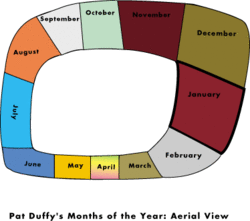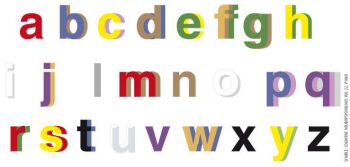Synaesthesia often seems strange to people who do not experience it. Here we answer some of the questions we are asked most frequently.
Q. How common is synaesthesia?
Q. How many different types of synaesthesia are there?
Q. What is the most common type of synaesthesia?
Q. Do different synaesthetes agree on what colour letters should be?
Q. Is it possible for a synaesthete to have more than one type of synaesthesia?
Q. Can synaesthesia occur for taste and smell?
Q. Can synaesthesia occur for touch and other bodily sensations?
Q. Are there any advantages or disadvantages to having synaesthesia?
Q. Are the brains of synaesthetes different?
Q. Does it run in families?
Q. Are women more likely to have synaesthesia than men?
Q. Do identical twins have identical synaesthesia?
Q. I always think of numbers/alphabet/calendar as having a particular spatial form. Is this synaesthesia?
Q. I see coloured auras around people. Is this synaesthesia?
Q. What is the youngest age at which it has been reported in the literature?
Q. Can synaesthesia ever be lost?
Q. Can synaesthesia be acquired?
Q. Is there a relationship between synaesthesia and artistic talent?
Q. Are synaesthetes more likely to be left handed?
Q. Which famous people have synaesthesia?
Q.1 How common is synaesthesia?
In order to find out how common synaesthesia is, Ward conducted an experiment on passers-by at London's Science Museum, and Simner conducted a similar study on the undergraduate population in Edinburgh, Scotland (Simner et al. 2006). As well as asking people whether they experienced colour when they saw, heard or thought about letters and numbers we also devised a computer test in which black letters and numbers were flashed on the screen and people had to choose a colour as quickly as possible. Most people chose randomly but those with synaesthesia were very reliable in their choice of colours. This enabled us to estimate that this type of synaesthesia occurred in a little over one percent of the population. A similar result was found in Edinburgh, and the Edinburgh study was also able to consider other types of synaesthesia too. Coloured days of the week were more common that we had originally expected, but we were able to observe less common types such as tasting shapes, and coloured music. In total, we were able to identify 22 synaesthetes out of 500 students who were initially screened (4.4%). The figure will be higher if other types of synaesthesia (e.g. experiencing numbers or time in space) is considered. ^
Q.2 How many different types of synaesthesia are there?
The synesthesia tree website lists over 300! However, many of these types are closely related. For example, people who have days-colour are likely to have months-colour. Our own research suggests that these different types can be organised into 'families' or groupings of related types and there are probably only 5-10 of these. These include: language-colour, language-taste, language-touch, 'visualised sensations', sequence-space, mirror-touch, tickertape, and hearing-motion. ^
Q.3 What is the most common type of synaesthesia?
 Our research suggests that experiencing days and months in colour is probably the most common type of synaesthesia that involves one of the traditional five senses. Experiencing days, months, number and the alphabet in a spatial form (e.g. in lines, circles, spirals) is even more common (maybe 10 percent of the population). Most research on synaesthesia has concentrated on colours for letters and numbers. These synaesthetes typically experience colours whenever they see letters, hear letter names and even think about letters (e.g. A=red, B=blue, C=yellow). Words also tend to have colours that are derived from one or more of their constituent letters. Most people have a 'feeling' of colour but they don't actually see the ink or paper as being coloured (although some synaesthetes do). Synaesthetic colours generally co-exist with 'real' colours and they do not override each other. Colour is by far the most common experience of synaesthetes, although it can be triggered by a whole host of things and not just letters. ^
Our research suggests that experiencing days and months in colour is probably the most common type of synaesthesia that involves one of the traditional five senses. Experiencing days, months, number and the alphabet in a spatial form (e.g. in lines, circles, spirals) is even more common (maybe 10 percent of the population). Most research on synaesthesia has concentrated on colours for letters and numbers. These synaesthetes typically experience colours whenever they see letters, hear letter names and even think about letters (e.g. A=red, B=blue, C=yellow). Words also tend to have colours that are derived from one or more of their constituent letters. Most people have a 'feeling' of colour but they don't actually see the ink or paper as being coloured (although some synaesthetes do). Synaesthetic colours generally co-exist with 'real' colours and they do not override each other. Colour is by far the most common experience of synaesthetes, although it can be triggered by a whole host of things and not just letters. ^
Q.4 Is it possible for a synaesthete to have more than one type of synaesthesia?
Yes, around half of all synaesthetes have more than one type of synaesthesia, such as taste, sound and touch all producing colours. The fact that different types of synaesthesia co-occur in the same individuals suggests that there is a common cause for all types of synaesthesia, rather than every type of synaesthesia having its own independent cause. ^
Q.5 Do different synaesthetes agree on what colour letters should be?
No and yes. If you put two synaesthetes together then they will typically argue over the colour of letters! However, if one looks at a larger sample of synaesthetes then some trends can be discerned. For instance, 'A' is often red, 'B' is often blue, 'C' is often yellow and so on. The image on the right shows the most common colours experienced by English speaking synaesthetes (figure from Simner, 2007). This is likely to hold true for other types of synaesthesia, assuming we are able to make a large enough number of observations. For instance, certain musical instruments may tend to produce particular colours, shapes and movements even though there will also be a significant amount of individual variation. ^
Q.6 Can synaesthesia occur for taste and smell?
Yes, and this is something that we have actively researched in our lab. For instance, we are in contact with a number of people in whom spoken words produce taste (Ward & Simner, 2003; Ward et al. 2005; Simner & Ward, 2006). 'Taste' is not the best description for these cases, as the experiences have texture, location (e.g. edge of tongue, back of throat) and temperature as well as taste. The experiences can be highly specific (e.g. runny egg yolk). The other common type of synaesthesia involving taste is when taste produces colour sensations (e.g. Downey, 1911) or tactile shapes (Cytowic, 1993) . As for smell, Harrison (2001) notes a case in which smell produces shapes and Raines (1909) notes a case of odours producing colours but this type of synaesthesia seems to be very rare. ^
Q.7 Can synaesthesia occur for touch and other bodily sensations?
Yes, it was once thought to be very rare but we now think it is one of the most common types of synaesthesia. We have documented people who experience touch just by looking at someone else being touched, and we call this 'mirror touch' synaesthesia. Most people assumed it was 'normal', i.e. they assumed that everyone else experienced things this way too, and hence it was undetected until 2005 (Blakemore et al., 2005; Banissy & Ward, 2007). Having some form 'mirror pain' occurs in about a quarter of the population (Grice-Jackson et al., 2017), Feelings of pain or touch can sometimes trigger synaesthetic experiences of vision/colour (e.g. Whipple, 1990; Dudycha & Dudycha, 1935). There is one known in case in which words trigger feelings of bodily movement (e.g. Devereaux, 1966). ^
Q.8 Are there any advantages or disadvantages to having synaesthesia?
Synaesthesia has no known effects on IQ and synaesthetes do not stand out from other members of society in any way - it is quite possible that you have acquaintances who are synaesthetic without even realising it. Most synaesthetes could not imagine life without their experiences and are either positively disposed towards it ("I feel so sorry for people who don't have this"), or neutral ("it is like being asked whether you enjoy having a left arm - it is just there, and I neither like it nor dislike it"). For some people, however, synaesthetic perceptions can be intrusive and disrupt their chain of thought if they have a particularly intense sensation. Synaesthesia may have some benefits on memory. One of the most famous synaesthetes, Shereshevsky (Luria, 1966), actually made a living out of being a memory expert! We have shown that many synaesthetes have better memory for a wide variety of things (Ward, Field, & Chin, 2019). They report being good at learning languages, but this could possibly be related to the known benefits to memory. On the negative side, many synaesthetes report having difficulties with numbers, navigation, and sports/coordination (Rich et al., 2005). ^
Q.9 Are the brains of synaesthetes different?
Yes, but not in a way that is problematic or reflects pathology. Most theories of synaesthesia talk about re-wiring or extra-connections in the brain. White matter, which connects different regions together, in the brains of people with synaesthesia is organised differently (Rouw & Schulte, 2007) and there is more grey matter in some regions of the brain relating to perception and attention. Another brain imaging study has shown that when certain synaesthetes hear spoken words then the parts of the brain normally dedicated to colour are used (Nunn et al., 2002). This suggests that parts of the brain that are normally used to process colour derived from vision are used instead to process colour derived from speech. ^
Q.10 Does it run in families?
Yes. Around 40 percent of synaesthetes know of at least one other family member who has it (Ward & Simner, 2005). The relative is not always immediate family. For example, you could have a synaesthetic cousin, but have non-synaesthetic brothers and sisters. It can also skip generations. For example, it could be that no living relative has it but that, say, your great-grandparents did have it. Synaesthetes often choose not to discuss their synaesthesia with their family in case they are dismissive of it. It is possible for a synaesthete to 'come out' late in life, only to find that their brother or sister or parent has been privately experiencing something very similar. The type of synaesthesia isn't strongly heritable. So someone with taste synaesthesia often has a family member with the, more common, types of colour synaesthesia (Ward et al. 2005). ^
Q.11 Are women more likely to have synaesthesia than men?
No. It was once well accepted that synaesthesia was more common in women than men (Baron-Cohen et al. 1996) but other research has shown that this is not the case (Simner and Carmichael, 2015). One reason for the apparent difference is that men may be less likely to come forward and volunteer for research and less likely to admit to having synaesthesia. ^
Q.12 Do identical twins have identical synaesthesia?
No. Most twins seem to have different colours and different types of synaesthesia (but see Hancock, 2006, for an exception). It is even possible to have genetically identical male or female twins with only one twin having synaesthesia (Bosley & Eagleman, 2015). This does not disprove a genetic contribution to synaesthesia, but it does prove that genetic make-up isn't everything. This could also explain why synaesthesia can sometimes skip a generation or more. In these instances, it is probably just as likely that the non-synaesthetic twin will have synaesthetic children as the synaesthetic twin. ^
Q.13 I always think of numbers/alphabet/calendar as having a particular spatial form. Is this synaesthesia?
Some people might think of numbers having a particular arrangement in space. For example, the numbers 1 to 10 being arranged on the lower left hand side of the person (near the hip); this turns right at number 11 and then makes a 30 degree turn at number 50, before stretching to infinity after the number 100. Similar things are reported for the alphabet, days and months, and other sequences (e.g. Sagiv et al. 2006). Although this sort of thing often falls outside a strict definition of the word 'synaesthesia' (a mixing of the senses), it is widely acknowledged that these experiences often go hand in hand. Other non-sensory synaesthetic phenomena include assigning genders to things (e.g. 'A' is a male letter; this is not related to grammatical gender that occurs in some languages), and personifications (e.g. thinking of letters as personalities!). The standard explanation is that the brain changes that give rise to synaesthesia also give rise to changes in non-sensory parts of the brain. ^
Q.14 I see coloured auras around people. Is this synaesthesia?
Possibly. Although some people are attracted to more mystical explanations. The aura might be triggered by the physical properties of the face, but more often than not the colour of the aura seems to relate to the persons mood or character traits (Collins, 1929; Riggs & Karwoski, 1934). There are now several cases in the literature of synaesthetes who only experience colours for the names of people that they personally know well (Ward, 2004; Weiss et al, 2001). ^
Q.15 What is the youngest age at which it has been reported in the literature?
The youngest documented case in the literature was a three-and-a-half year old boy (Whitchurch, 1922), in whom noises produced colour (e.g. an electric fan sounded orange, and a frog bluish). There are a few studies that have studied how synaesthesia develops over time. During literacy acquisition (6 to 8 years) children develop more and more stable colour associations for letters but this still don't yet reach adult levels (Simner et al., 2009). It is not clear whether synaesthesia exists in a less stable form before this, or whether these children have other forms of synaesthesia that they lose as a result of becoming literate. ^
Q.16 Can synaesthesia ever be lost?
We know of a number of people who claim that they used to experience synaesthesia but no longer do (normally dropping out before the age of 10). It has also been suggested that we were all born with synaesthesia but that it tends to get lost within the first few years of life (e.g. Maurer & Mondloch, 2004). Of course, it is impossible to ask infants what they are experiencing but there is good evidence that infants have a greater mixing of the senses than adults or older children. Synaesthesia in adulthood could also potentially be lost or diminished by chemical or organic changes in the brain. Sacks and Wasserman (1987) reports a case of a synaesthetic painter who suffered brain damage to the colour part of his brain. Not only did this result in an inability to experience 'real' colour (he now perceived the world in black and white), but also his synaesthetic colours vanished too. Another person reported that he lost his spatial numbers after a brain injury (Spalding & Zangwill, 1957). ^
Q.17 Can synaesthesia be acquired?
Yes, but the properties of acquired synaesthesia are somewhat different to those associated with the naturally occurring type. Hallucinogenic drugs such as LSD, magic mushrooms and mescaline can all produce transient forms of synaesthesia (e.g. Hartman & Hollister, 1963). For instance, Albert Hoffmann was the first person to note the psychoactive properties of LSD when he accidentally ingested or breathed it. His lab notes (19th April 1943) clearly describe synaesthesia: "It was particularly striking how acoustic perceptions such as the noise of a passing auto, the noise of water gushing from the faucet or the spoken word, were transformed in to optical illusions." The synaesthesia disappears as the effect of the drug wears off. Although some people can experience 'flashbacks', we are not aware of anyone who claims to have permanently acquired synaesthesia as a result of drug use. Other people have acquired synaesthesia after becoming progressively blind (e.g. Armel & Ramachandran, 1999). It is unclear whether the synaesthesia in these cases is permanent or transient. ^
Q.18 Is there a relationship between synaesthesia and artistic talent?
 "Yellow, Red, Blue" by Wassily Kandinsky
"Yellow, Red, Blue" by Wassily Kandinsky
Synaesthetes are more likely to choose art as a hobby or occupation, although the effect is most pronounced for one type of synaesthesia: namely, visualising music. We suggest that the beauty of these experiences motivates them to create art (Ward et al. 2007) rather than synaesthesia giving them 'talent' (which is a difficult thing to measure or judge). ^
Q.19 Are synaesthetes more likely to be left handed?
No. We have analysed a large sample of synaesthetes on a very detailed questionnaire (50 questions) about various aspects of handedness and laterality. People with synaesthesia are just as likely to be left handed as people who do not have synaesthesia (about 10% of the each group). Other researchers have reported the same finding (e.g. Rich et al. 2005). ^
Q.20 Which famous people have synaesthesia?
The most likely cases are David Hockney and Wassily Kandinsky (artist), Vladimir Nabokov (author of Lolita), Olivier Messiaen (composer), Ludwig Wittgenstein (philosopher), Pharrel Williams (pop star), Billie Eilish (singer), Geoffrey Rush (actor), and Richard Feynman (Nobel prize-winning physicist). ^
NOTE: These views are the opinions of the authors and should not be taken as fact, although we have cited the relevant evidence when appropriate.


